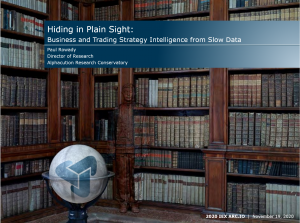Welcome to Alphacution’s Document Library. The purpose of this repository is to showcase Alphacution’s deeper and more comprehensive research relative to the analysis found on our Feed. Note that some of the reports found here may have been commissioned by clients, excerpted and distributed by alliance partners, or developed in conjunction with our network of collaborators.
Note that these documents are available as PDFs. Depending on your browser’s behavior and Acrobat Reader Plugin availability, the PDF will display within your browser or will automatically download.
Payment For Order Flow 2020, Part III: The Retail Flow Factor
In this 17-page, 21-exhibit presentation – Part III of Alphacution’s case study on payment for order flow (PFOF) – we present our preliminary development of the “retail flow factor” for 2020 based largely on a reconciliation of 606 data (from 10 retail brokers / 11 entities) and 605 data (from 7 wholesale market makers). The results include estimated monthly penetration of retail order flow relative to the full U.S. cash equities market for 2020 – including estimated breakdowns of odd lots and round lots – as well as some hints on where we will need to look next to further refine this factor in preparation for extending this analysis throughout 2021 and beyond…
Payment For Order Flow 2020, Part II: Broker Personas
In Part I of Alphacution’s case study on payment for order flow (PFOF), we focused mainly on the rates paid by wholesale market makers to retail brokers under a full range of securities categories and order type scenarios. In this 22-page, 20-exhibit deck, Alphacution presents PART II of its upcoming comprehensive case study, The Robinhood Effect, with a focus on a concept called broker personas. Alphacution’s working hypothesis on this topic is that each retail broker – in fact, all order flow intermediaries – have a unique persona. This persona – a unique pattern formed by order type distributions – is a distillation of client trading behaviors. In this presentation, Alphacution demonstrates that broker personas are partly due to investor demographics and, more interestingly, partly due to broker influence. Furthermore, when we broaden our perspective to consider that retail brokers are now compensated for trade flows largely by their wholesaler counterparts, we see a clearer picture of how desired outcomes could be manufactured…
Payment For Order Flow 2020, Part I: Rate Heatmaps
2020 will be remembered for many reasons. In the context of Alphacution’s ongoing research focus, we want to remember 2020 as the first full year of enhanced transparency into the mechanics and impacts of the long-held practice of payment for order flow (PFOF). It turns out, enhanced use of PFOF as the linchpin in a new zero-commission brokerage framework for retail investors (pioneered by Robinhood) sets a series of dominoes in motion that ultimately influence, to some degree, all stakeholders and all products in US listed markets. The question now is: To what end? In this 23-page, 20-exhibit deck, Alphacution presents PART I of its upcoming comprehensive case study, The Robinhood Effect, with a focus on order routing rate heatmaps.
Rise of Hudson River Trading – Executive Summary
In this 91-page, 102-exhibit case study, “The Rise of Hudson River Trading,” Alphacution adds another leading proprietary trading firm – and recent entrant to the $1 billion+ trading revenue club (2020e) – to its library focused on the most secretive and consequential players in the global markets ecosystem. Notable highlights include the history of Sun Trading and the impacts of its acquisition by Hudson River Trading (HRT) in Q1 2018, and explorations into the firm’s European trading operations, US equity and equity option strategies, comparative analysis with select competitors, and revenue estimation, among many other details. An executive summary is available for review and download by open subscribers (w/ free registration). The complete case study is available to premium subscribers or via individual report purchase.
Rise of Hudson River Trading
In this 91-page, 102-exhibit case study, “The Rise of Hudson River Trading,” Alphacution adds another leading proprietary trading firm – and recent entrant to the $1 billion+ trading revenue club (2020e) – to its library focused on the most secretive and consequential players in the global markets ecosystem. Notable highlights include the history of Sun Trading and the impacts of its acquisition by Hudson River Trading (HRT) in Q1 2018, and explorations into the firm’s European trading operations, US equity and equity option strategies, comparative analysis with select competitors, and revenue estimation, among many other details. An executive summary is available for review and download by open subscribers (w/ free registration). The complete case study is available to premium subscribers or via individual report purchase.
2020 IEX ARC.IO Presentation: Hiding in Plain Sight
This is the presentation given at the 2020 IEX ARC.IO virtual conference on November 19, 2020. It outlines the research vision and mission for Alphacution’s research, lists core data sources (to date), provides an overview of our asset management ecosystem thesis (including capacity of alpha), and draws specifically from notable exhibits in our comprehensive cases studies on the likes of Citadel Securities, Susquehanna International Group (SIG), Two Sigma Investments (including certain comparisons to D. E. Shaw), and Jane Street Group.
Full Title – Hiding in Plain Sight: Business and Trading Strategy Intelligence from Slow Data
History of Jane Street – Executive Summary
In this 125-page, 149-exhibit, 26,000-word case study, “History of Jane Street,” Alphacution sets a new bar for the scope of a case study focused one of the leading proprietary trading and market making firms in the world, with notable expansions relative to prior cases studies into regional, US option strategy, revenue estimation, and comparative analysis details (including Citadel Securities, Susquehanna International Group (SIG) and affiliates, and Two Sigma Investments and affiliates). The complete case study is available to premium subscribers or via individual report purchase.
History of Jane Street
In this 125-page, 149-exhibit, 26,000-word case study, “History of Jane Street,” Alphacution sets a new bar for the scope of a case study focused one of the leading proprietary trading and market making firms in the world, with notable expansions relative to prior cases studies into regional, US option strategy, revenue estimation, and comparative analysis details (including Citadel Securities, Susquehanna International Group (SIG) and affiliates, and Two Sigma Investments and affiliates). The complete case study is available to premium subscribers or via individual report purchase.
Two Sigma Investments, LP and Affiliates – Executive Summary
In this 51-page, 61-exhibit case study on one of the most successful quantitative trading firms launched since the dawn of the 21st century – Two Sigma Investments, LP – Alphacution presents the next in its series of unprecedented reports based on its modeling of many of the most mythological players and impactful themes operating within the current global asset management ecosystem. Of particular note, this report includes a groundbreaking comparative analysis of key strategy parameters between Two Sigma and D. E. Shaw, with additional analytical comparisons that include Millennium Management and Renaissance Technologies; together a grouping of the most revolutionary asset managers in the large-scale quantitative domain. The complete case study is available to premium subscribers or via individual report purchase.
Two Sigma Investments, LP and Affiliates
In this 51-page, 61-exhibit case study on one of the most successful quantitative trading firms launched since the dawn of the 21st century – Two Sigma Investments, LP – Alphacution presents the next in its series of unprecedented reports based on its modeling of many of the most mythological players and impactful themes operating within the current global asset management ecosystem. Of particular note, this report includes a groundbreaking comparative analysis of key strategy parameters between Two Sigma and D. E. Shaw, with additional analytical comparisons that include Millennium Management and Renaissance Technologies; together a grouping of the most revolutionary asset managers in the large-scale quantitative domain. The complete case study is available to premium subscribers or via individual report purchase.
Susquehanna International Group, LLP – Executive Summary
In this 55-page, 64-exhibit case study on one of the most legendary proprietary option trading firms of all time – Susquehanna International Group, LLP – Alphacution publishes the next installment in its unprecedented Hiding in Plain Sight series that leverages an assembly of publicly-available data and a growing library of models based on some of the most impactful market participants in the global asset management ecosystem today. The complete case study is available to premium subscribers or via individual report purchase.
Susquehanna International Group, LLP
In this 55-page, 64-exhibit case study on one of the most legendary proprietary option trading firms of all time – Susquehanna International Group, LLP – Alphacution publishes the next installment in its unprecedented Hiding in Plain Sight series that leverages an assembly of publicly-available data and a growing library of models based on some of the most impactful market participants in the global asset management ecosystem today. The complete case study is available to premium subscribers or via individual report purchase.
Deconstructing Citadel Securities – Executive Summary
In this 55-page, 45-exhibit case study on market making powerhouse, Citadel Securities, Alphacution continues to expand its unprecedented Hiding in Plain Sight series to explore the unique trading engines and business strategies of the most successful, noteworthy – and mythological – asset managers in the world by presenting its latest storyboard based an assembly of data that lies open to the public. The complete case study is available to premium subscribers or via individual report purchase.
Deconstructing Citadel Securities
In this 55-page, 45-exhibit case study on market making powerhouse, Citadel Securities, Alphacution continues to expand its unprecedented Hiding in Plain Sight series to explore the unique trading engines and business strategies of the most successful, noteworthy – and mythological – asset managers in the world by presenting its latest storyboard based an assembly of data that lies open to the public. The complete case study is available to premium subscribers or via individual report purchase.
The Complete Case Study on Spot Trading
In this 32-page, 38-exhibit case study on the proprietary option trading firm, Spot Trading, that closed in late 2017, Alphacution showcases the information and insights that can be harvested from a cache of data that is hiding in plain sight. This report is also intended to educate clients and our broader network about the mechanics and drivers of macro-market structure, as well as to provide a template that will begin to set expectations for the nature of premium content that is being made available as part of Alphacution’s emerging research subscription service. The full report is available to registered users for download here:
The Context Machine: Estimating Asset Manager Technology Spending – Executive Summary
In this 48-page, 35-exhibit study, Alphacution goes to new lengths to apply the axiom that effective management requires effective measurement – and begins the process of supporting its hypothesis that there are persistent – and ultimately, predictable – relationships between trading and operational factors for asset managers. With most asset managers being private, support for this hypothesis also means that technology spending – a rarely observable data item in this universe – can be estimated with more readily observable and contextual data about AUM and employee headcount. Moreover, it turns out that by understanding the relative positioning of technology capital (via spending patterns) with that of human capital, we achieve an unprecedented and quantitative level of understanding about the underlying scope of automation embedded in that firm’s strategy selections. These findings ultimately give birth to Alphacution’s Asset Manager Ecosystem Map, and the deeper exploration into its structural alpha, active management, and passive management zones. The complete case study is available to premium and silver subscribers or via individual report purchase.
Context Machine: Estimating Asset Manager Technology Spending
In this 48-page, 35-exhibit study, Alphacution goes to new lengths to apply the axiom that effective management requires effective measurement – and begins the process of supporting its hypothesis that there are persistent – and ultimately, predictable – relationships between trading and operational factors for asset managers. With most asset managers being private, support for this hypothesis also means that technology spending – a rarely observable data item in this universe – can be estimated with more readily observable and contextual data about AUM and employee headcount. Moreover, it turns out that by understanding the relative positioning of technology capital (via spending patterns) with that of human capital, we achieve an unprecedented and quantitative level of understanding about the underlying scope of automation embedded in that firm’s strategy selections. These findings ultimately give birth to Alphacution’s Asset Manager Ecosystem Map, and the deeper exploration into its structural alpha, active management, and passive management zones. The complete case study is available to premium and silver subscribers or via individual report purchase.
IT Services and Strategic Impacts for Global Banks: The Force Multiplier
This 33-page, 29-exhibit report – distributed under our alliance with Aite Group – applies Alphacution’s modeling methodologies to the global IT services sector and leverages that output to showcase the evolving role that IT services plays for global banks: Today, outsourced IT services are firmly embedded in all industries and most large corporations. Alphacution’s message to financial sector clients and other buyers of IT services is both blessing and curse: The global IT services sector continues to be dominated by lowest-cost, predominantly India-based human capital, and the motivation to engage with these services continues to be, as it seems to have been all along, about labor arbitrage, or the savings harvested from the reduction of high-cost, U.S.- or U.K.-based in-house human capital in favor of lowest-cost, leased human capital. Although the expectation to improve performance—via higher-quality output, more efficient output, or some other cocktail of innovation—is rarely made explicit, we believe that the potential for enhanced process efficiencies adds value to the equation. This is the blessing part. The potential curse is more nuanced…
Introducing the T-Greeks: Techno-Operational Analytics For Financial Services Enterprises
This 36-page, 29-exhibit study – a version of which was published under a data and analytics partnership with Aite Group in October 2016 entitled, “Return on Technology and the T-Greeks Framework: In the Beginning…” – introduces a new way of examining IT spending behavior within the financial services industry. It turns out that it does not matter what a firm spends on technology, after all. What actually matters most is what a firm receives for its investment in technology. In this report, Alphacution outlines its discovery that the return on technology (RoT) concept is quantifiable by normalizing and benchmarking the difference between performance (i.e., total net revenue) and the component cost of that performance (i.e., total technology spending). The four primary technology spending categories used in this modeling framework include 1) hardware and other infrastructure, 2) software and other data-processing functionality, including both internally generated and purchased software solutions, 3) IT-related human capital, including both technology and data management personnel, and 4) third-party data subscriptions. There are currently five closely related analytics within Alphacution’s T-Greeks framework, namely T-Spread, T-Beta, T-Alpha, T-Theta, and T-Vol. Finally, this study demonstrates that T-Greeks are actionable now. They can be strategically used to more efficiently monitor and navigate the ongoing business transformation process. Moreover, these analytics and benchmarks can be used for more tactical transformation, ultimately providing more detailed visibility for solution selection, shifts in the mix of human capital skills, and workflow re-engineering and replacement.
Quantifying the Transformation: Benchmarking Enterprise TCO for Global Banks
This 48-page, 36-exhibit report, which was initially published under a distribution rights agreement with Thomson Reuters in 2016, represents the first major study from Alphacution’s newly launched research platform. The findings in this content are based on the modeling of technology spending and other operational analytics from 58 of the largest banks in the world (representing 16 countries and 11 currencies) over the 11-year period 2005 to 2015. Chapter themes in this report include key drivers of the Global Financial Landscape, introduction and explanation of Alphacution’s Standardized TCO Framework, detailed review of the Analytical Foundation supporting Alphacution’s technology spending estimates, TCO Benchmark construction from various perspectives, and finally, the use of this modeling output to enhance Tactical Transformation as well as concluding remarks on one of Alphacution’s core research themes, “Return on Technology.” It turns out that what is most important about analyzing technology spending patterns is not the absolute spend, but the what firm receive for that spend.















